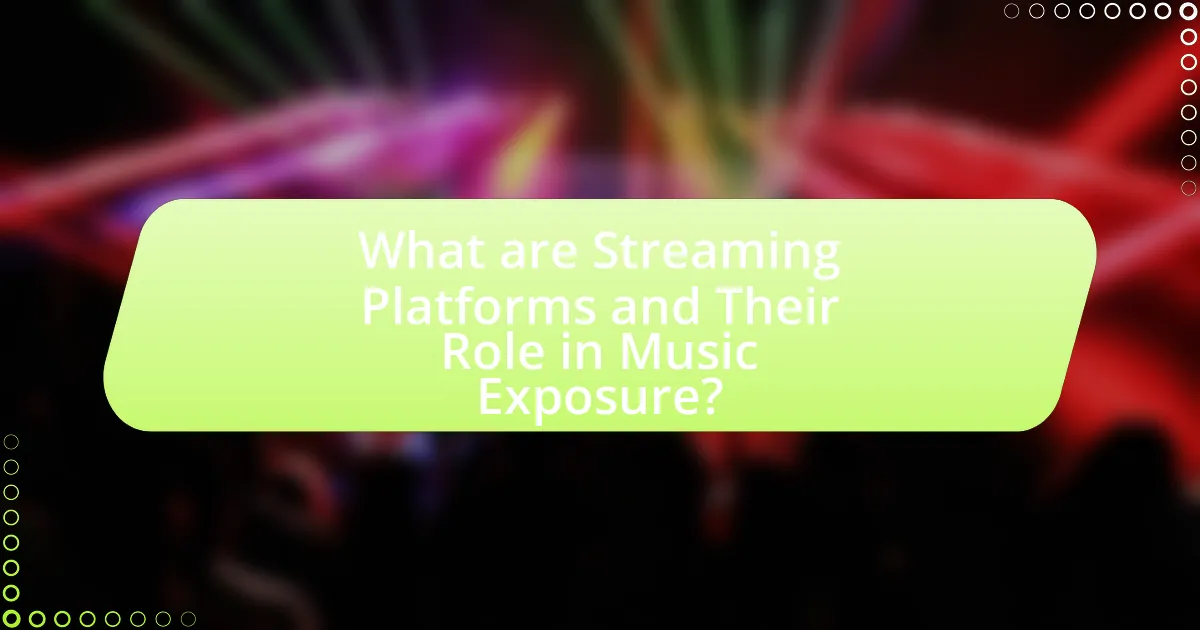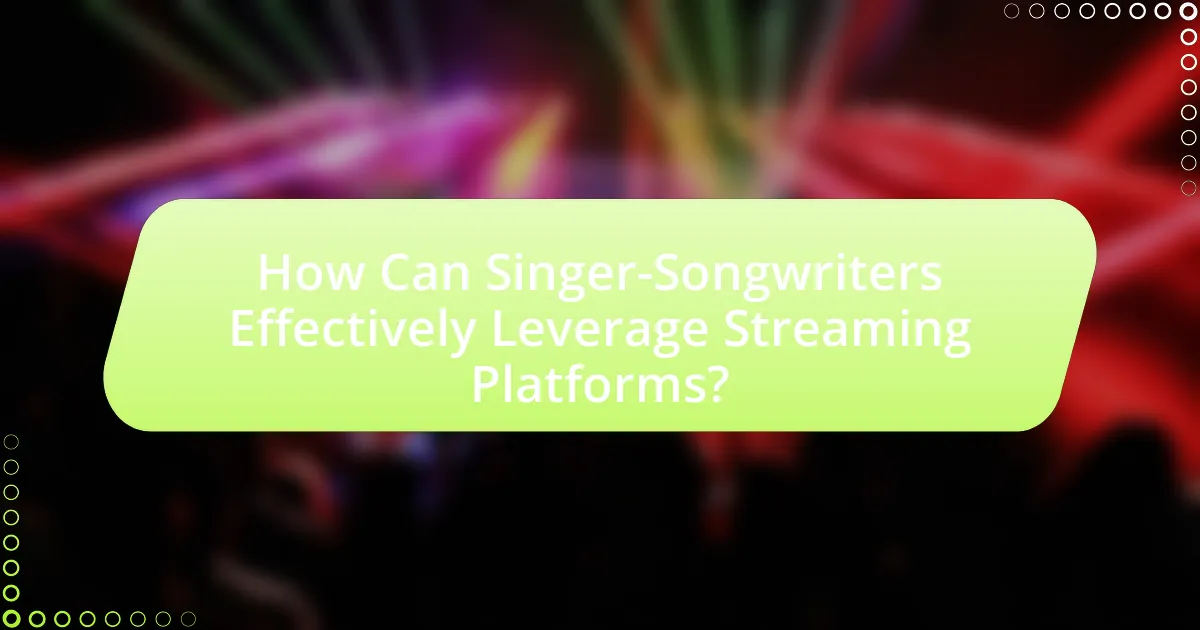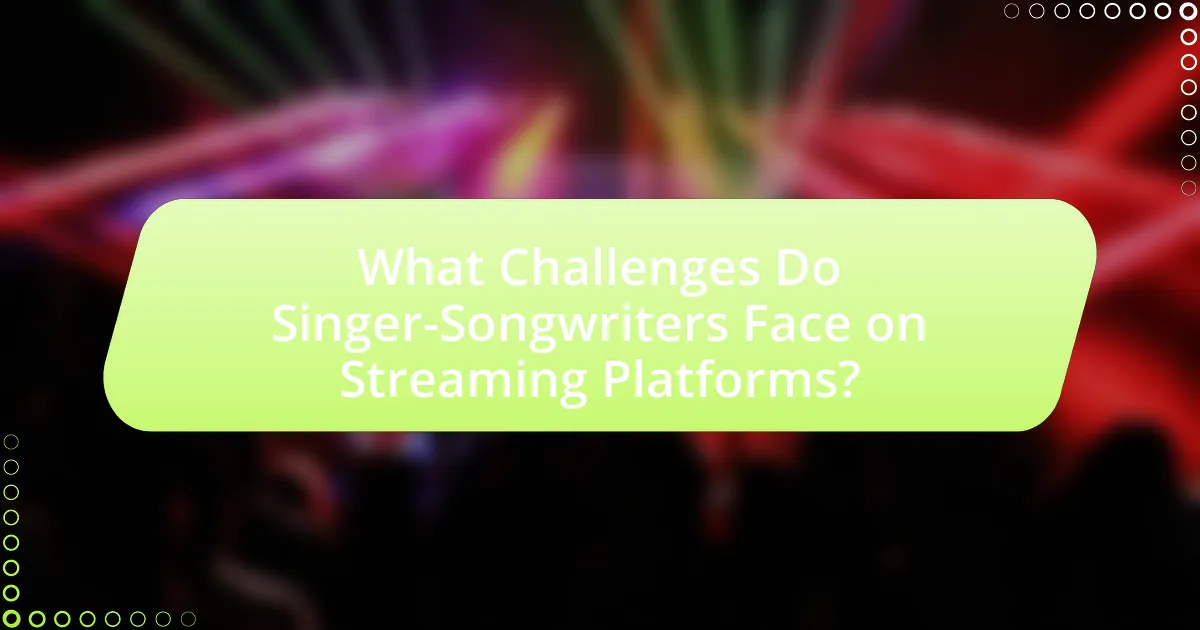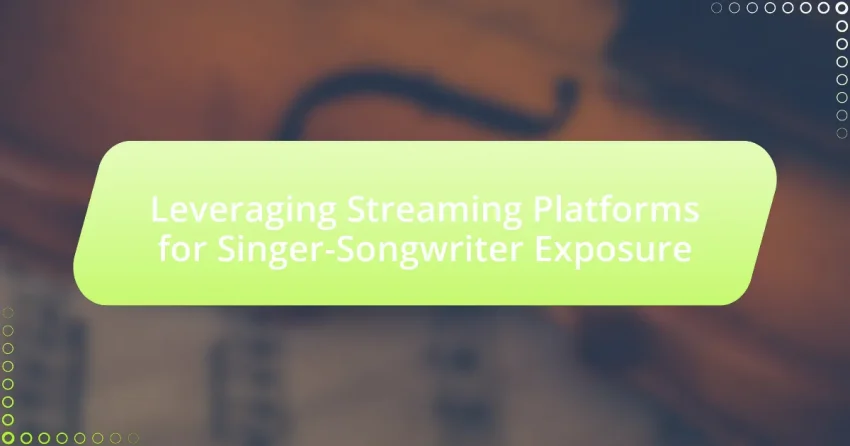Streaming platforms, such as Spotify, Apple Music, and YouTube Music, play a crucial role in enhancing music exposure for singer-songwriters by providing a global distribution channel and personalized recommendations. These platforms allow artists to upload their music, earn streaming royalties, and connect with audiences without traditional record label support. The article explores how algorithms influence music discovery, the advantages of streaming over traditional distribution, and strategies for maximizing presence on these platforms. Additionally, it addresses the challenges singer-songwriters face, including low revenue and competition, while offering actionable tips for building a loyal fanbase and leveraging collaboration for increased visibility.

What are Streaming Platforms and Their Role in Music Exposure?
Streaming platforms are digital services that allow users to access and listen to music online, significantly enhancing music exposure for artists. These platforms, such as Spotify, Apple Music, and YouTube Music, provide a vast catalog of songs and playlists, enabling listeners to discover new music easily. According to a 2021 report by the International Federation of the Phonographic Industry (IFPI), over 400 million people globally subscribed to paid streaming services, illustrating the widespread adoption of these platforms. This extensive reach allows singer-songwriters to gain visibility and connect with audiences that may not have been accessible through traditional music distribution channels.
How do streaming platforms function for artists?
Streaming platforms function for artists by providing a digital space where they can distribute their music to a global audience. These platforms, such as Spotify and Apple Music, allow artists to upload their tracks, which are then made available for streaming by users. Artists earn revenue through streaming royalties, which are calculated based on the number of times their songs are played. For instance, Spotify pays artists approximately $0.003 to $0.005 per stream, depending on various factors like the listener’s subscription type and the artist’s contract with the platform. This model enables artists to reach wider audiences, gain exposure, and potentially increase their fan base, while also generating income from their music.
What are the key features of popular streaming platforms?
Popular streaming platforms offer key features such as vast content libraries, personalized recommendations, user-friendly interfaces, and social sharing capabilities. These platforms, including Spotify, Apple Music, and YouTube, provide extensive catalogs of music and videos, allowing users to access millions of tracks and discover new artists. Personalized algorithms analyze user behavior to suggest content tailored to individual tastes, enhancing user engagement. Additionally, intuitive interfaces facilitate easy navigation, while social sharing features enable users to share their favorite songs and playlists with friends, fostering community interaction. These features collectively enhance the user experience and support artist exposure in the competitive music landscape.
How do algorithms influence music discovery on these platforms?
Algorithms significantly influence music discovery on streaming platforms by analyzing user behavior and preferences to recommend songs and artists. These algorithms utilize data such as listening history, song skips, and user interactions to create personalized playlists and suggestions, enhancing user engagement. For instance, Spotify’s recommendation system employs collaborative filtering and natural language processing to curate playlists like Discover Weekly, which has been shown to increase song plays by up to 30% for featured tracks. This data-driven approach not only helps listeners find new music but also elevates lesser-known artists, providing them with exposure based on listener trends and preferences.
Why are streaming platforms essential for singer-songwriters?
Streaming platforms are essential for singer-songwriters because they provide a wide-reaching distribution channel that allows artists to share their music globally. These platforms, such as Spotify and Apple Music, enable singer-songwriters to reach millions of listeners without the need for traditional record label support. According to the Recording Industry Association of America (RIAA), streaming accounted for 83% of the U.S. music industry’s revenue in 2020, highlighting its significance in the current music landscape. Additionally, streaming services offer data analytics that help artists understand their audience demographics and listening habits, allowing for targeted marketing and engagement strategies. This accessibility and insight make streaming platforms a crucial tool for singer-songwriters to build their careers and connect with fans.
What advantages do streaming platforms provide over traditional music distribution?
Streaming platforms offer greater accessibility and convenience compared to traditional music distribution. They allow users to instantly access vast libraries of music from anywhere with an internet connection, eliminating the need for physical media or downloads. According to a 2021 report by the Recording Industry Association of America (RIAA), streaming accounted for 83% of the U.S. music industry’s revenue, highlighting its dominance over traditional sales methods. Additionally, streaming platforms provide personalized recommendations and playlists, enhancing user engagement and discovery of new artists, which traditional distribution methods do not facilitate as effectively.
How do streaming platforms enhance audience reach for emerging artists?
Streaming platforms enhance audience reach for emerging artists by providing global accessibility and personalized recommendations. These platforms, such as Spotify and Apple Music, allow artists to distribute their music widely without the need for traditional record labels, reaching listeners across different countries instantly. Additionally, algorithms analyze user preferences to suggest new music, increasing the likelihood that emerging artists will be discovered by potential fans. For instance, Spotify’s “Discover Weekly” playlist has been credited with significantly boosting streams for lesser-known artists, demonstrating the effectiveness of algorithm-driven exposure.

How Can Singer-Songwriters Effectively Leverage Streaming Platforms?
Singer-songwriters can effectively leverage streaming platforms by utilizing data analytics, engaging with audiences through social media, and collaborating with other artists. Data analytics allows them to understand listener demographics and preferences, enabling targeted marketing strategies. Engaging with audiences on social media platforms fosters a community and encourages sharing of their music, which can increase streams. Collaborating with other artists can introduce their music to new audiences, enhancing visibility. According to a 2021 report by the International Federation of the Phonographic Industry, streaming accounted for 62% of global recorded music revenue, highlighting the importance of these platforms for artist exposure.
What strategies can singer-songwriters use to maximize their presence on streaming platforms?
Singer-songwriters can maximize their presence on streaming platforms by consistently releasing high-quality music, engaging with their audience through social media, and utilizing playlist placements. Regularly releasing new tracks keeps the artist relevant and increases chances of being featured in algorithm-driven playlists, which can significantly boost streams. Engaging with fans on platforms like Instagram and TikTok fosters a loyal community, encouraging shares and interactions that enhance visibility. Additionally, securing placements in popular playlists can lead to increased exposure; for instance, Spotify’s editorial playlists have been known to elevate artists’ profiles, as seen with numerous emerging musicians who gained substantial followings after being featured.
How important is playlist placement for singer-songwriters?
Playlist placement is critically important for singer-songwriters as it significantly enhances their visibility and audience reach. Being featured on popular playlists can lead to increased streams, higher chart positions, and greater opportunities for live performances. For instance, a study by Spotify revealed that tracks included in curated playlists can experience a 30% increase in streams compared to those not featured. This demonstrates that effective playlist placement can be a game-changer for emerging artists, allowing them to connect with new listeners and build a dedicated fan base.
What role does social media play in promoting music on streaming platforms?
Social media plays a crucial role in promoting music on streaming platforms by facilitating direct engagement between artists and their audience. This engagement allows artists to share new releases, behind-the-scenes content, and personal stories, which can significantly increase listener interest and streaming numbers. For instance, a study by the International Federation of the Phonographic Industry (IFPI) found that 70% of music consumers discover new music through social media platforms. Additionally, social media algorithms can amplify an artist’s reach, enabling their music to be shared virally, thus driving traffic to streaming platforms. This interconnectedness enhances visibility and can lead to increased playlist placements, further boosting an artist’s exposure and success in the competitive music landscape.
What are the best practices for engaging with listeners on streaming platforms?
The best practices for engaging with listeners on streaming platforms include consistent content updates, interactive communication, and leveraging social media integration. Consistent content updates keep listeners engaged and encourage them to return; for instance, artists who release new music or behind-the-scenes content regularly tend to maintain a loyal audience. Interactive communication, such as responding to comments and messages, fosters a sense of community and connection, which is crucial for listener retention. Additionally, integrating social media allows artists to reach a broader audience and engage with fans in real-time, enhancing their visibility and interaction. According to a study by the International Federation of the Phonographic Industry, artists who actively engage with their audience on multiple platforms see a 30% increase in listener loyalty.
How can singer-songwriters build a loyal fanbase through streaming services?
Singer-songwriters can build a loyal fanbase through streaming services by consistently releasing high-quality music and engaging with their audience. Regularly updating their profiles with new tracks, EPs, or albums keeps listeners interested and encourages repeat streams. Engaging with fans through social media platforms and responding to comments fosters a sense of community and loyalty.
Additionally, utilizing playlists on streaming platforms can significantly increase visibility; for instance, being featured on popular playlists can lead to a substantial increase in streams and followers. According to a report by Spotify, artists who are included in curated playlists see an average increase of 30% in their monthly listeners.
Moreover, leveraging data analytics provided by streaming services allows singer-songwriters to understand their audience better, tailoring their marketing strategies and music releases to meet listener preferences. This data-driven approach enhances the connection with fans, ultimately leading to a more dedicated following.
What types of content can enhance listener engagement on these platforms?
Interactive content, such as live Q&A sessions, behind-the-scenes videos, and personalized playlists, can significantly enhance listener engagement on streaming platforms. These types of content foster a sense of community and connection between the artist and the audience. For instance, live Q&A sessions allow listeners to interact directly with the artist, creating a more personal experience. Behind-the-scenes videos provide insight into the creative process, making listeners feel more invested in the artist’s journey. Additionally, personalized playlists can cater to specific listener preferences, increasing the likelihood of repeated engagement. Research indicates that interactive content can boost audience retention rates by up to 70%, demonstrating its effectiveness in enhancing listener engagement.

What Challenges Do Singer-Songwriters Face on Streaming Platforms?
Singer-songwriters face significant challenges on streaming platforms, primarily related to revenue generation, visibility, and competition. Revenue from streaming is often minimal; for instance, artists typically earn between $0.003 and $0.005 per stream, making it difficult for independent musicians to sustain a living solely from these platforms. Additionally, visibility is a major hurdle, as algorithms favor established artists, making it challenging for emerging singer-songwriters to gain traction. According to a report by the Music Industry Research Association, over 60% of independent artists struggle to be discovered on major streaming services due to the sheer volume of content available. Lastly, intense competition from both established and new artists further complicates the landscape, as singer-songwriters must continuously innovate and market themselves to stand out.
What common obstacles do singer-songwriters encounter when using streaming platforms?
Singer-songwriters commonly encounter low revenue from streaming platforms, as they receive only a fraction of a cent per stream. This financial model makes it challenging for independent artists to sustain their careers, with reports indicating that artists earn an average of $0.003 to $0.005 per stream. Additionally, singer-songwriters face difficulties in gaining visibility due to algorithm-driven playlists that often favor established artists, limiting exposure for emerging talent. Furthermore, the oversaturation of content on these platforms can make it hard for new music to stand out, leading to increased competition and reduced chances of discovery.
How can competition on streaming platforms impact visibility for new artists?
Competition on streaming platforms can significantly reduce visibility for new artists by overwhelming listeners with choices. As millions of tracks compete for attention, algorithms often favor established artists or trending songs, making it challenging for newcomers to gain traction. For instance, Spotify’s algorithm prioritizes playlists that feature popular tracks, which can limit exposure for lesser-known artists. According to a 2021 report by the International Federation of the Phonographic Industry, 70% of music streams come from the top 1% of artists, illustrating how competition skews visibility towards established names. This dynamic creates barriers for new artists trying to break into the market, as they struggle to be discovered amidst a vast array of content.
What are the financial implications of streaming for singer-songwriters?
Streaming has significant financial implications for singer-songwriters, primarily characterized by lower per-stream payouts compared to traditional music sales. For instance, platforms like Spotify pay between $0.003 and $0.005 per stream, which means that a song would need millions of streams to generate substantial income. This model often leads to a reliance on live performances and merchandise sales for a majority of their revenue, as streaming alone typically does not cover production and marketing costs. Additionally, the increased accessibility of music through streaming can lead to greater exposure, potentially increasing opportunities for licensing, collaborations, and fan engagement, which can indirectly enhance financial stability.
How can singer-songwriters overcome these challenges?
Singer-songwriters can overcome challenges by strategically utilizing streaming platforms to enhance their visibility and audience engagement. By consistently releasing high-quality music and leveraging social media for promotion, they can build a loyal fan base. Data shows that artists who engage with their audience through platforms like Instagram and TikTok see a significant increase in streaming numbers, with a 30% rise in listener engagement reported by Spotify for artists who actively promote their work online. Additionally, collaborating with other musicians can expand their reach, as cross-promotion often leads to increased exposure to new audiences.
What resources are available to help artists navigate streaming platforms?
Artists can utilize various resources to navigate streaming platforms effectively. These resources include online guides and tutorials provided by platforms like Spotify for Artists and Apple Music for Artists, which offer insights into optimizing profiles, understanding analytics, and promoting music. Additionally, industry blogs such as Hypebot and Digital Music News provide articles and tips on best practices for streaming success. Furthermore, social media groups and forums, such as those on Facebook and Reddit, allow artists to share experiences and strategies. According to a report by MIDiA Research, 70% of artists who actively engage with these resources see improved visibility and engagement on streaming platforms.
How can collaboration with other artists enhance exposure on streaming platforms?
Collaboration with other artists enhances exposure on streaming platforms by allowing each artist to tap into the other’s audience, thereby increasing reach and visibility. When artists collaborate, they often share their work across their respective social media channels and playlists, which can lead to a significant increase in streams and followers. For instance, a study by Spotify indicated that collaborative tracks often receive up to 50% more streams than solo tracks, as they attract listeners from both artists’ fan bases. This mutual promotion not only broadens the audience but also fosters networking opportunities that can lead to further collaborations, creating a cycle of increased exposure.
What are the key takeaways for singer-songwriters using streaming platforms?
Singer-songwriters should prioritize building a strong online presence and engaging with their audience on streaming platforms. This engagement can lead to increased visibility and fan loyalty. Additionally, utilizing data analytics provided by these platforms helps artists understand listener demographics and preferences, allowing for targeted marketing strategies. According to a 2021 report by the International Federation of the Phonographic Industry, streaming accounted for 62% of global recorded music revenue, highlighting the importance of these platforms for income generation. Furthermore, collaborating with other artists on these platforms can expand reach and introduce singer-songwriters to new audiences.
What actionable tips can help singer-songwriters succeed on streaming platforms?
To succeed on streaming platforms, singer-songwriters should focus on consistent content release, effective social media promotion, and playlist placements. Regularly releasing new music keeps the audience engaged and increases visibility; for instance, artists who release music every few months tend to maintain listener interest and grow their fan base. Utilizing social media platforms to promote music and connect with fans can significantly enhance reach; studies show that artists with active social media profiles see higher streaming numbers. Additionally, securing placements on popular playlists can dramatically increase streams; data indicates that songs featured on curated playlists can experience a surge in plays by up to 300%.
How can continuous learning and adaptation improve a singer-songwriter’s strategy on streaming platforms?
Continuous learning and adaptation can significantly enhance a singer-songwriter’s strategy on streaming platforms by enabling them to respond effectively to audience preferences and industry trends. By analyzing data from streaming analytics, such as listener demographics and engagement metrics, singer-songwriters can tailor their music and marketing strategies to better align with what resonates with their audience. For instance, a study by Nielsen Music found that artists who actively engage with their audience and adapt their content based on feedback see a 30% increase in listener retention. This iterative process of learning and adapting not only helps in refining their musical style but also in optimizing promotional efforts, ultimately leading to increased visibility and success on streaming platforms.
